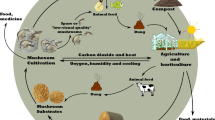Abstract
The influence of environmental parameters on mycelial linear growth ofPleurotus ostreatus, P. eryngii, P. pulmonarius, Agrocybe aegerita, Lentinula edodes, Volvariella volvacea andAuricularia auricula-judae was determined in two different nutrient media in a wide range of temperature, forming the basis for the assessment of their temperature optimaV. volvacea grew faster at 35°C,P. eryngii at 25°C,P. ostreatus andP. pulmonarius at 30°C,A. aegerita at 25 or 30°C andA. auricula-judae at 20 or 25°C depending on the nutrient medium used andL. edodes at 20 or 30°C depending on the strain examined. The mycelium extension rates were evaluated on seven mushroom cultivation substrates: wheat straw, cotton gin-trash, peanut shells, poplar sawdust, oak sawdust, corn cobs and olive press-cake. The mycelium extension rates (linear growth and colonization rates) were determined by the ‘race-tube’ technique, and were found to be the highest on cotton gin-trash, peanut shells and poplar sawdust forPleurotus spp. andA. aegerita. Wheat straw, peanut shells and particularly cotton gin-trash supported fast growth ofV. volvacea, whereas wheat straw was the most suitable substrate forL. edodes andA. auricula-judae. Supplemented oak sawdust and olive press-cake were poor substrates for most species examined, white almost all strains performed adequately on corn cobs.
Similar content being viewed by others
References
Chandra A., Purkayastha R.P.: Physiological studies on Indian edible mushrooms.Trans. Brit. Mycol. Soc. 69, 63–70 (1977).
Chang S.C., Steinkraus K.H.: Lignocellulolytic enzymes produced byVolvariella volvacea, the edible straw mushroomAppl. Environ. Microbiol. 43, 440–446 (1982).
Chang-Ho Y., Yee N.T.: Comparative study of the physiology ofVolvariella volvacea andCoprinus cinereus.Trans. Brit. Mycol. Soc. 68, 167–172 (1977).
Eggins H.O.W., Pugh G.J.F.: Isolation of cellulose-decomposing fungi from the soil.Nature 193, 94–95 (1962).
Han Y.H., Ueng W.T., Chen L.C., Cheng S.: Physiology and ecology ofLentinus edodes (Berk.) Sing.Mush. Sci. 11, 623–658 (1981).
Ioannidou S., Zervakis G., Phillippoussis A., Diamantopoulou P.: Influence of the air temperature and the composition of nutrient media on the linear growth rates of selected edible mushroom species, in L. Van Griensven (Ed.):Proc. 15th Internat. Congr. Science and Cultivation of Edible Fungi. Balkema, Rotterdam (Netherlands) 2000.
Mayson E., Verachtert H.: Growth of higher fungi on wheat straw and their impact on the digestibility of the substrate.Appl. Microbiol. Biotechnol. 36, 421–424 (1991).
Nerud F., Mišurcová Z.: Distribution of ligninolytic enzymes in selected white-rot fungi.Folia Microbiol. 41, 264–266 (1996).
Noble R., Grogan H., Elliott T.J.: Variation in morphology, growth and fructification of isolates in theAgaricus subfloccosus complex.Mycol. Res. 99, 1453–1461 (1995).
Philippoussis A., Diamantopoulou P., Zervakis G., Ioannidou S.: Potential for the cultivation of exotic mushroom species by exploitation of Mediterranean agricultural wastes, pp. 523–530 in L. Van Griensven (Ed.):Proc. 15th Internat. Congr. Science and Cultivation of Edible Fungi. Balkema, Rotterdam (Netherlands) 2000.
Philippoussis A., Zervakis G., Diamantopoulou P.: Biocoversion of agricultural lignocellulosic wastes through the cultivation of the edible mushroomsAgrocybe aegerita, Volvariella volvacea andPleurotus sp.World J. Microbiol. Biotechnol., in press (2001).
Philippoussis A., Zervakis G.: Cultivation of edible mushrooms in Greece: presentation of the current status and analysis of future trends, pp. 843–848 in L. Van Griensven (Ed.):Proc. 15th Internat. Congr. Science and Cultivation of Edible Fungi. Balkema, Rotterdam (Netherlands) 2000.
Poppe J.: Use of agricultural waste materials in the cultivation of mushrooms, pp. 3–23 in L. Van Griensven (Ed.):Proc. 15th Internat. Congr. Science and Cultivation of Edible Fungi Balkema, Rotterdam (Netherlands) 2000.
Smith J.F., Wood D.A., Thurston C.F.: Growth measurement ofAgaricus mycelium in composted substrates as an indicator of compost selectivity and mushroom productibity, pp. 293–301 in T. Elliott (Ed.):Proc. 14th Internat. Congr. Science and Cultivation of Edible Fungi. Balkema, Rotterdam (Netherlands) 1995.
Straatsma G., Gerrits J.P.G., Gerrits T.M., Huub J.M., Op Den Camp, Van Griensven L.: Growth kinetics ofAgaricus bisporus mycelium on solid substrate (mushroom compost).J. Gen. Microbiol. 137, 1471–1477 (1991).
Tripothi J.P., Yadar J.S.: Optimization of solid substrate fermentation of wheat straw into animal feed byPleurotus ostreatus—a pilot effort.Anim. Feed Sci. Technol. 37, 59–72 (1992).
Wiegant W.M., Wery J., Buitenhuis E.T., De Bont J.A.M.: Growth-promoting effect of thermophilic fungi on the mycelium of the edible mushroomAgaricus bisporus.Appl. Environ. Microbiol. 58, 2654–2659 (1992).
Zervakis G., Balis C.: A pluralistic approach on the study ofPleurotus species, with emphasis on compatibility and physiology of the European morphotaxa.Mycol. Res. 100, 717–731 (1996).
Zervakis G., Venturella G.: Mushroom breeding and cultivation favorsex situ conservation of MediterraneanPleurotus taxa.Proc. Internat. Conf. Science and Technology for Managing Plant Genetic Diversity in the 21st Century. IPGRI, Kuala Lumpur (Malaysia), in press (2000).
Author information
Authors and Affiliations
Rights and permissions
About this article
Cite this article
Zervakis, G., Philippoussis, A., Ioannidou, S. et al. Mycelium growth kinetics and optimal temperature conditions for the cultivation of edible mushroom species on lignocellulosic substrates. Folia Microbiol 46, 231–234 (2001). https://doi.org/10.1007/BF02818539
Received:
Revised:
Issue Date:
DOI: https://doi.org/10.1007/BF02818539




